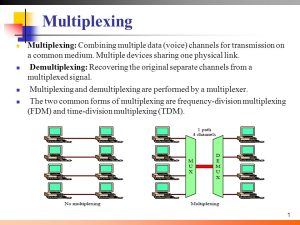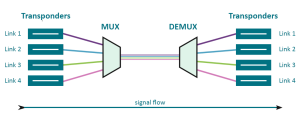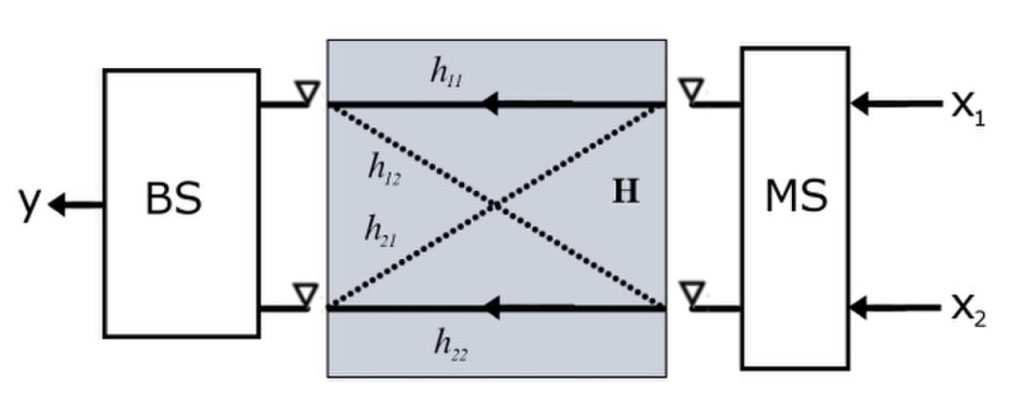Spatial multiplexing is a perplexing technique employed in MIMO systems that bursts with excitement as it enables the transmission of multiple data streams concurrently. The process involves transmitting various data streams through different antennas, which are then received by corresponding antennas at the receiving end. This bursty approach has revolutionized wireless communication by significantly increasing capacity and throughput.

One of the mysteries behind spatial multiplexing in MIMO systems is its ability to deliver higher channel capacity. It’s almost as if this method holds an invisible key that unlocks more information transmission without causing any interference or signal quality degradation. Moreover, precoded spatial multiplexing takes things up another notch and makes it possible to transmit multiple data streams using fewer antennas than traditional MIMO techniques require.
However, antenna selection mystifies even experienced engineers when implementing spatial multiplexing into MIMO systems – wrong choices can cause poor performance due to increased interference and decreased SNR levels. Hence, designing an optimal system model while selecting appropriate RF front-end components becomes crucial for solving this puzzle effectively while minimizing errors caused by improper antenna selection.
The Advantages of MIMO and Spatial Multiplexing in Wireless Communications
Contents
- 1 The Advantages of MIMO and Spatial Multiplexing in Wireless Communications
- 2 Limitations of Antenna Selection in MIMO Spatial Multiplexing
- 3 Modulation Schemes and their Impact on Channel Capacity in MIMO Systems
- 4 The Importance of Channel State Information in MIMO Spatial Multiplexing
- 5 Error Performance and BER Performance in MIMO Systems
- 6 The Role of Coding and Feedback Channels in MIMO Spatial Multiplexing
- 7 Achievable Data Rates and Throughput in MIMO Systems
Perplexingly enough, multiplexing is a technique that permits multiple signals to be transmitted over a single communication channel. However, in MIMO systems, the use of spatial multiplexing – another type of perplexing multiplexing – takes advantage of both transmitter and receiver’s multiple antennas to burst data transmission rates. Burstiness has become increasingly popular in wireless communications due to its ability to achieve high data rates without requiring additional bandwidth.

The advantages of MIMO systems with spatial multiplexing are quite puzzling when compared to traditional single-antenna systems. The most significant and perplexing advantage is improved error performance, which leads to fewer dropped calls and better call quality. Additionally, simulation results have shown that MIMO spatial multiplexing can significantly improve signal strength whilst reducing interference from other wireless devices operating on the same frequency band.
Another confounding benefit of MIMO spatial multiplexing is increased throughput. By using multiple antennas at both the transmitter and receiver, more data can be transmitted simultaneously compared with traditional single-antenna systems resulting in faster download speeds for users and less congestion on wireless networks.
Overall, it’s paradoxical how this intricate technology offers significant benefits for wireless communications by improving error performance while increasing throughput all whilst reducing interference from other devices operating on the same frequency band. It’s staggering how as technology continues to advance we can expect even greater improvements in MIMO system design that will further enhance these advantages for users around the world!
Limitations of Antenna Selection in MIMO Spatial Multiplexing
The perplexing aspect of MIMO spatial multiplexing lies in the limitations presented by antenna selection. The IEEE 802.11n standard mandates four antennas for transmission and reception, yet hardware constraints allow only two to be utilized at a time, thereby reducing the number of available transmit and receive chains. This limitation casts a shadow over achievable data rates and spectral efficiency.
Modulation schemes also add complexity to channel capacity and SNR performance in MIMO systems through their impact on channel matrices or vectors generated by different combinations of transmit-receive antennas during antenna selection. Such unique properties affect signal processing both at transmitter and receiver ends, making optimal antenna combinations critical to achieving high throughput while maintaining low BER levels.
Beamforming techniques are often used as a remedy for poor signal quality by focusing energy towards specific directions using multiple antennas’ phase shifts; however, beamforming requires accurate CSI feedback from receivers to optimize parameters accurately—a feedback overhead that increases with more involved transmission/reception channels leading to reduced spectral efficiency.
In conclusion, although antenna selection is crucial for improving wireless communications’ capabilities via MIMO technology’s implementation, it presents notable challenges such as increased complexity due to CSI feedback requirements and limited availability of transmit-receive chains that can adversely affect achieved data rates when modulation schemes are not optimized correctly within these systems.
Modulation Schemes and their Impact on Channel Capacity in MIMO Systems
The channel capacity of multiple input multiple output (MIMO) systems is significantly influenced by modulation schemes. MIMO spatial multiplexing, which takes advantage of numerous antennas, allows for high-speed data transmission by transmitting independent data streams simultaneously on different antenna paths that are later demultiplexed at the receiver.
However, selecting an appropriate modulation scheme can be a perplexing task as it depends on multiple factors such as channel state information (CSI), error performance and bit error rate (BER). CSI plays a vital role in determining the optimal precoded spatial multiplexing scheme to achieve maximum capacity.
Error performance and BER also pose critical challenges when deciding on suitable modulation techniques for MIMO communication systems. While higher order constellations may lead to increased throughput rates, they may also decrease the system’s tolerance to errors due to heightened noise susceptibility. Striking a balance between these two parameters is therefore imperative while choosing an appropriate constellation size or coding technique for MIMO systems.
In conclusion, selecting an optimal modulation scheme is crucial in achieving reliable communication and high data rates in MIMO spatial multiplexing systems. To ensure efficient utilization of available spectral resources without compromising system reliability or robustness under varying wireless channel conditions, factors such as CSI, error performance and BER must be considered when making decisions regarding suitable modulation strategies.
The Importance of Channel State Information in MIMO Spatial Multiplexing
The proposed MIMO system’s success is heavily reliant on the channel state information (CSI), a concept that can be quite perplexing. In wireless communication, CSI refers to the understanding of the channel matrix between transmitter and receiver – a seemingly obscure idea that must be accurately grasped in order to achieve high multiplexing gain and data rates.
To avoid erroneous results caused by imprecise CSI, it is imperative to obtain dependable feedback from receivers about their individualized channel conditions. This feedback can be procured through several methods such as pilot signals or dedicated feedback channels – methods that may seem bursty but are critical for optimal performance compared to single-input single-output systems.
Interestingly, simulation results posit that utilizing an appropriate precoder with advanced modulation schemes could further boost MIMO system performance when combined with accurate CSI. Equally important is implementing proper channel coding techniques for error correction within MIMO spatial multiplexing systems.
Thus, having precise knowledge of the channel state information remains crucial for optimizing achievable data rates and throughput in MISO systems while maintaining high reliability levels without compromising spectral efficiency or power consumption requirements.
Error Performance and BER Performance in MIMO Systems
The perplexing nature of MIMO systems lies in the crucial role that modulation schemes play in achieving high data rates. The minimum error probability, as measured by the bit error rate (BER) performance at a given signal-to-noise ratio (SNR), is indicative of system success. To enhance data rates, it’s critical to maximize BER across all channels.
Enter feedback channels – a bursty solution for enhancing BER performance in MIMO systems. By transmitting channel state information from both transmit and receive ends, adaptive transmission techniques can optimize overall system performance considerably. For instance, space-time block coding (STBC) with feedback has been shown to outperform other techniques when considering average bits per channel use.
But wait! Recent research presented at an international LTE conference suggests that STBC scheme with 0° phase rotation could significantly improve BER performance even further by maximizing minimum errors across all channels using varied antenna configurations comprising single and multiple transmits antennas.
In conclusion, optimizing error and BER performances remains essential for achieving high throughput levels within MIMO systems.
The Role of Coding and Feedback Channels in MIMO Spatial Multiplexing
In the realm of MIMO spatial multiplexing, coding and feedback channels hold a paramount position. The coding method employed in MIMO systems can exert tremendous influence on the attainable data rates. To bolster the system’s dependability, Forward Error Correction (FEC) is usually utilized to append redundancy bits that empower error correction by decoders in response to noise or interference. However, FEC entails additional overhead which curbs the throughput of the system.
Feedback channels are indispensable for MIMO systems as they furnish information about channel conditions at both communication terminals. This information is critical for optimizing transmit precoding schemes aimed at improving signal quality while minimizing interference between streams transmitted over different antennas. In essence, these techniques align signals emanating from diverse antennas along high-channel-gain directions and reduce transmission power towards low-channel-directions thereby enhancing spectral efficiency.
The modulation scheme selected also impacts performance in MIMO systems featuring spatial multiplexing capability. A higher-order signal constellation packs more bits per symbol but necessitates a higher Signal-to-Noise Ratio (SNR) threshold to maintain acceptable Symbol Error Probability (SEP). Conversely, lower complexity constellations like QPSK outmatch 16QAM or 64QAM when there exists significant channel correlation between antenna elements or if there are limited numbers of antennas available on either side of communication. Additionally, using orthogonal codes such as Alamouti code guarantees minimum Euclidean distance between symbols transmitted over varying antennas without having to employ complex decoding algorithms at receiver end; this makes it suitable for practical applications such as IEEE 802.11n standard wireless LANs where cost constraints and real-time processing requirements mandate low-complexity decoders be used instead.
Achievable Data Rates and Throughput in MIMO Systems
The incredible advantages of MIMO systems are truly mind-boggling, as they possess the capability to achieve unprecedented data rates and throughput. Through spatial multiplexing, multiple streams can be transmitted concurrently, causing the available bandwidth for communication to swell dramatically. Furthermore, utilizing a finite set of modulation schemes contributes significantly towards improving rate performance.
However, when it comes to practical implementation of these systems, attaining maximum achievable rates becomes incredibly challenging due to an array of factors that are enough to make anyone’s head spin. One significant obstacle is antenna selection; choosing poorly correlated antennas among transmit and receive paths can lead to reduced system performance. Moreover, in real-world scenarios where perfect CSI (channel state information) may not always be available – achieving high-speeds becomes even more perplexing.
Nevertheless, modern wireless standards such as 802.11ac have managed to impressively demonstrate their ability by reaching remarkable achievable data rates using MIMO technology despite the hurdles encountered along the way. For instance: under ideal conditions with perfect CSI and acknowledgement feedback channels – 802.11ac devices can reach up to 1 Gbps at roughly 10 meters with an SNR (signal-to-noise ratio) around 17 dB.
Overall then while computation complexity remains a challenge for MIMO systems with large numbers of antennas or complex algorithms – one thing is certain: multiple-input-multiple-output technology has allowed for enormous improvements in wireless communication speed and reliability over recent years through its high-rate performance capabilities coupled with interference suppression techniques amongst many other benefits!


